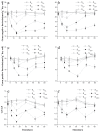Microbial community dynamics during the bioremediation process of chlorimuron-ethyl-contaminated soil by Hansschlegelia sp. strain CHL1
- PMID: 25689050
- PMCID: PMC4331280
- DOI: 10.1371/journal.pone.0117943
Microbial community dynamics during the bioremediation process of chlorimuron-ethyl-contaminated soil by Hansschlegelia sp. strain CHL1
Abstract
Long-term and excessive application of chlorimuron-ethyl has led to a series of environmental problems. Strain Hansschlegelia sp. CHL1, a highly efficient chlorimuron-ethyl degrading bacterium isolated in our previous study, was employed in the current soil bioremediation study. The residues of chlorimuron-ethyl in soils were detected, and the changes of soil microbial communities were investigated by phospholipid fatty acid (PLFA) analysis. The results showed that strain CHL1 exhibited significant chlorimuron-ethyl degradation ability at wide range of concentrations between 10μg kg-1 and 1000μg kg-1. High concentrations of chlorimuron-ethyl significantly decreased the total concentration of PLFAs and the Shannon-Wiener indices and increased the stress level of microbes in soils. The inoculation with strain CHL1, however, reduced the inhibition on soil microbes caused by chlorimuron-ethyl. The results demonstrated that strain CHL1 is effective in the remediation of chlorimuron-ethyl-contaminated soil, and has the potential to remediate chlorimuron-ethyl contaminated soils in situ.
Conflict of interest statement
Figures






References
-
- Lamoureux GL, Rusness DG, Tanaka FS (1991) Chlorimuron ethyl metabolism in corn. Pesticide biochemistry and physiology 41: 66–81.
-
- Zawoznik MS, Tomaro ML (2005) Effect of chlorimuron‐ethyl on Bradyrhizobium japonicum and its symbiosis with soybean. Pest management science 61: 1003–1008. - PubMed
-
- Zhang X, Li X, Zhang C, Li X, Zhang H (2011) Ecological risk of long-term chlorimuron-ethyl application to soil microbial community: an in situ investigation in a continuously cropped soybean field in Northeast China. Environmental science and pollution research international 18: 407–415. 10.1007/s11356-010-0381-4 - DOI - PubMed
Publication types
MeSH terms
Substances
LinkOut - more resources
Full Text Sources
Other Literature Sources
Miscellaneous

